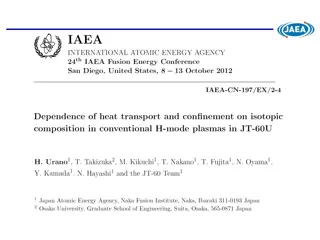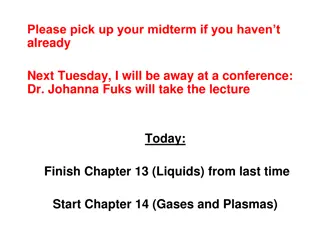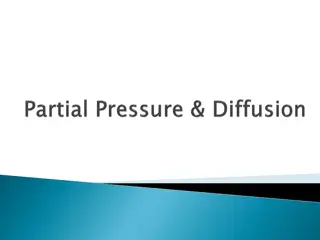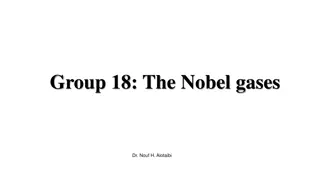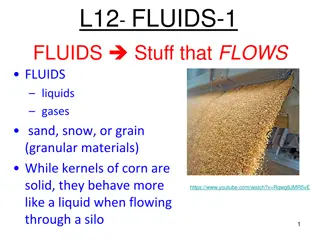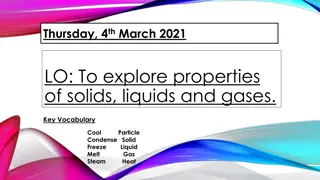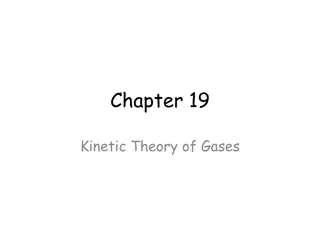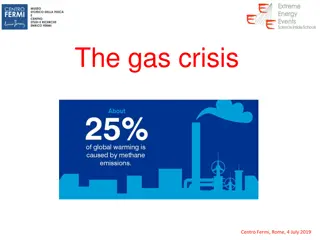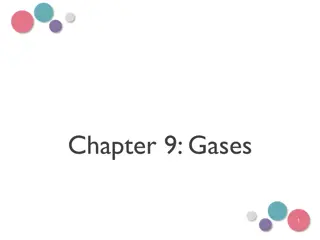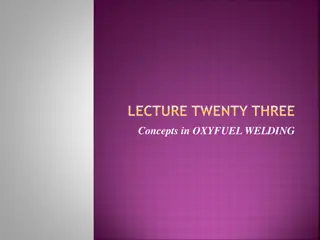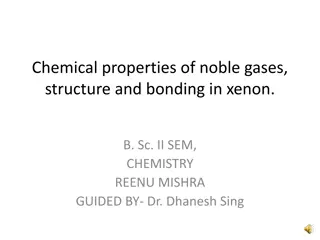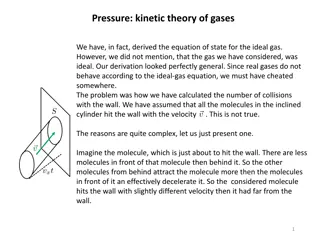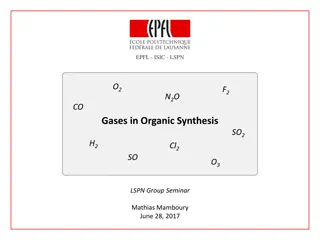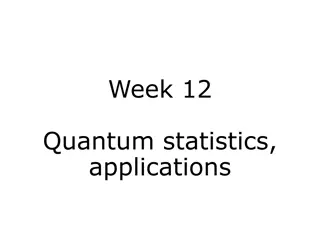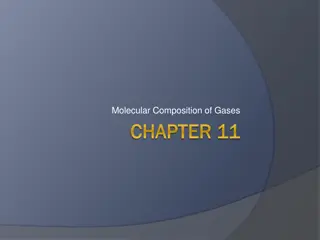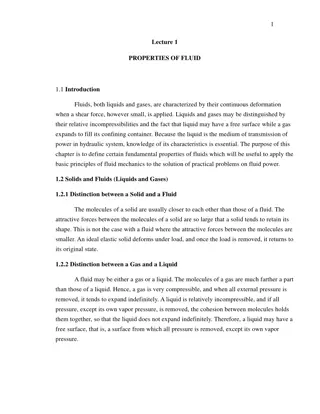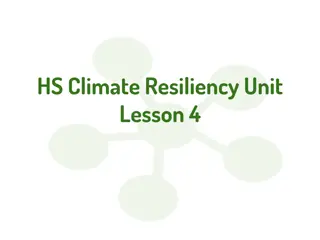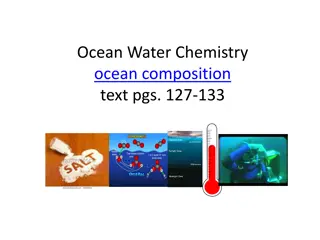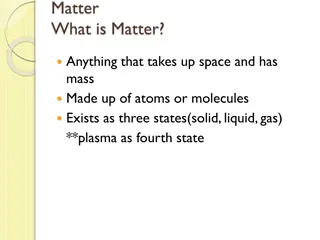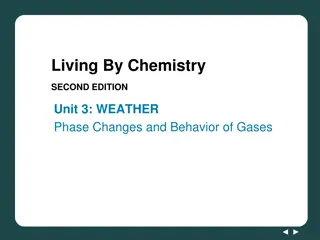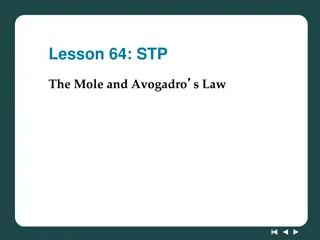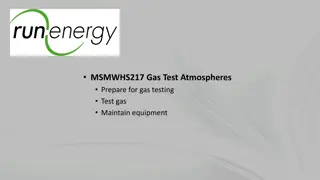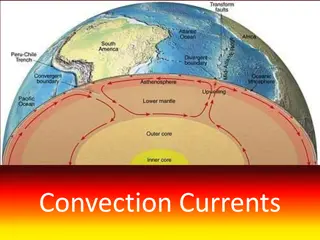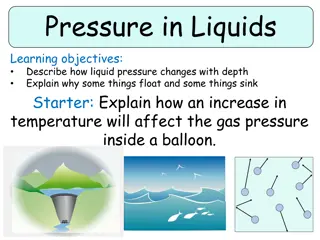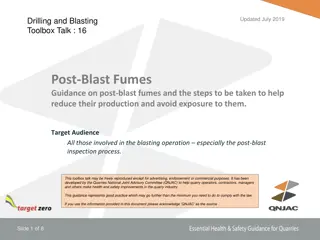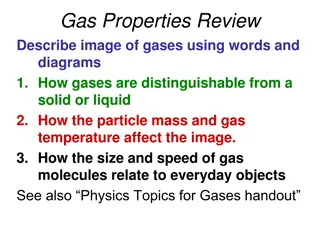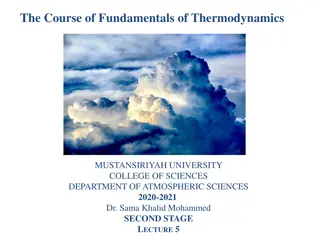Exploring the Fascinating World of Gases and Plasmas in Chapter 14
Delve into the intriguing realm of gases and plasmas as we transition from liquids in Chapter 13. Understand the dynamics of fluid pressure, buoyancy, and the unique characteristics that differentiate gases from liquids. Explore examples illustrating the concepts and ponder over the mysteries of our atmosphere's thickness and the enigma of its vastness. Discover the wonders of atmospheric pressure and the captivating balance between kinetic energy and gravity that sustains our breathable atmosphere.
Download Presentation

Please find below an Image/Link to download the presentation.
The content on the website is provided AS IS for your information and personal use only. It may not be sold, licensed, or shared on other websites without obtaining consent from the author. Download presentation by click this link. If you encounter any issues during the download, it is possible that the publisher has removed the file from their server.
E N D
Presentation Transcript
Today: Finish Chapter 13 (Liquids) Start Chapter 14 (Gases and Plasmas)
Gases and plasmas: Preliminaries Will now apply concepts of fluid pressure, buoyancy, flotation of Ch.13, to the atmosphere. Main difference between a liquid like water and a gas like air is that in the gas, the density can vary hugely; our atmosphere s density is depth dependent unlike liquid s Gases vs liquids: both are fluids but molecules in gas are far apart and can move much faster, free from cohesive forces. A gas will expand to fill all space available Note! An empty cup is not really empty it s filled with air. In fact a 1 m3 empty cube of air has a mass of 1.25 kg (at sea level).
Example Before you go grocery shopping you check what s in the refrigerator and find only a large orange. Which weighs more, the air in the fridge, or the orange? The fridge has a volume of about 0.75 m3. The air in the fridge! The mass density of air at 0o C and normal atmospheric pressure is about 1.25 kg/m3 (see last slide). So the mass of air in the fridge is (mass density) x volume = 1.25 x 0.75 = 0.94 kg. i.e ~ 2 pounds. This is more than a large orange. Note:We don t notice the weight of air because we are submerged in air. If someone handed you a bag of water while you were submerged in water, you wouldn t notice its weight either. A fish also forgets about the weight of water just like we don t notice weight of air.
The atmosphere What determines the thickness of our atmosphere? Balance between: kinetic energy of molecules vs gravity spreads molecules apart holds molecules near earth Consider extremes: (i) If very little gravity (eg on moon), then molecules would move, collide, and eventually disappear into space. So no atmosphere. (ii) If gravity very strong c.f. kinetic energy (eg on a remote planet), molecules move too slowly, and form a liquid or solid, like the planet itself so again no atmosphere. Earth balance between the two effects, so we do fortunately have an atmosphere! (we can breathe!!)
Exactly how tall is the atmosphere? Not a meaningful question, since it gets thinner and thinner as you go higher and higher. Even in interplanetary space, have about 1 gas molecule (mostly hydrogen) every cubic meter. Air is least dense up here and most dense here
Atmospheric Pressure Atmosphere exerts pressure, like water in a lake. We are at the bottom of an ocean of air . Magdeburg hemisphere experiment (1654): Make sphere from 2 copper hemispheres, m in diameter. Evacuate the sphere with vacuum pump. Two teams of 8 horses each couldn t pull the spheres apart! What is holding the two hemispheres so tightly together? Atmospheric pressure outside, no pressure inside (since vacuum). Rather than being sucked together , they are pushed together by air molecules. Same idea behind why the weight is lifted when air is pumped out here no pressure inside cylinder, so unbalanced atmos pressure outside pushes piston upwards, raising the weight..
Question: Why is it hardly possible to drink sodas on the moon with straws? Because what makes the drink go up the straw is atmospheric pressure which is essentially zero on the moon. It s this that pushes the drink up the straw on earth in the straw your sucking created much less pressure than outside straw. i.e. when drinking with a straw, it s the atmospheric pressure that pushes the drink up to your mouth where there is less pressure since by sucking you re reducing the air pressure in your mouth. DEMO: ( tease your friends at the bar with this!) You can t drink much this way, because of the straw poking outside the pressure inside your mouth is not reduced by sucking since air is entering your mouth.
Atmospheric pressure cont. Unlike water, density of atmosphere varies with height, so pressure relation in terms of depth is not as simple. Not uniform. At sea level, 1 m3 of air has mass of 1.25 kg At 10km height, 1 m3 of air has mass of 0.4 kg (this is why need additional mass of air to pressurize airplanes). Recall Pressure = Force/area = weight/area. So to find pressure at sea level, need to calculate weight of a column of air rising up to top of atmosphere, say about 30 km. Find that a 1m2 area cylinder, 30 km high, has mass of 10 000kg. i.e. weight of 100 000 N. So pressure = 100 000 N/ (1 m)2 = 100 kPa Precisely, sea-level atmospheric pressure = 101.3 kPa 1 Pa = 1 N/m = Pascal
Clicker Question It would be easier to pull evacuated Magdeburg hemispheres apart when they are A) 20 km above the ocean surface. B) at sea level. C) 20 km beneath the ocean surface. D) held upside down. E) none of these Answer: A It s atmospheric pressure that we have to counter. This is least higher up in the atmosphere out of the given options.
Question: Why doesn t the pressure of the atmosphere make our building collapse ? of the walls of our building, so there is no net force. Atmospheric pressure is exerted on both the inside and outside Note that the building (or at least glass windows) can collapse if the pressure is changed a lot on one side (eg tornadoes )
Barometers vacuum Measure pressure of atmosphere Simple mercury barometer: Fill tube with mercury and then turn upside down into dish. Mercury runs out into the dish until level in tube is 76 cm, as shown. Why 76cm? Because, of pressure balance: barometer balances when weight of liquid in tube exerts same pressure as atmosphere outside. It s 76cm, regardless of how wide the tube is: weight of any 76cm column of mercury equals weight of same width column of 30 km of air. If atmospheric pressure increases, then air pushes down harder on the mercury , so column pushed up higher than 76 cm.
Barometers cont. How about a barometer made of water? Why not but how tall would the glass tube have to be? The weight of the water column would need to be the same weight as 76cm column of mercury, but density of water is 13.6 x less than the density of mercury hence, water barometer would have to be (at least) 13.6 x 76cm = 10.3 m tall. Again, regardless of tube s width. This also explains why you can t get water to be more than 10.3m tall, with a vacuum pump.
Buoyancy of Air An object surrounded by air is buoyed up by a force equal to the weight of the air displaced. c.f. Archimedes principle for liquids in the previous chapter. An object will rise in air (ie float upward) if its density is less than air s density: Why? (c.f. sinking vs floating in previous chapter) Downward grav force (= weight-density x volume) is then less than upward buoyant force (= weight-density-of-air x volume). So there is a net upward force. Eg. He-gas filled balloon (or heated air balloon since hot air is less dense than normal air) Greater buoyancy if the helium could be evacuated but not practical since how would keep the balloon sides from collapsing in? Could use stronger material but then weight is too large, so wouldn t rise at all
Clicker Question The buoyant force on a bird is largest when it flies A)Closer to the ground B)Higher in the atmosphere C)It is the same at whatever height it is at Answer: A The buoyant force is the weight of the air displaced. If we assume the bird s volume does not change too much, then since the weight-density of the air decreases at higher altitudes, the buoyancy force does too. (but note that birds don t fly due to the buoyant force flight is more complicated, to do with lift , part of this is Bernouilli s effect, see soon)
Clicker Question A large block of styrofoam and a small block of iron give identical weights when measured on a weighing scale. Which has greater mass? A) The styrofoam B) The iron C) They have the same mass Hint: First answer which experiences a larger buoyancy force? Note that the weight of anything measured in air is gravitational force minus buoyant force. Answer: A, the styrofoam Because of its greater volume, the styrofoam displaces more air so experiences larger buoyancy force upwards. The weight of anything measured in air is its true weight (mg) minus buoyant force if this net force is same for both, then the mg of styrofoam must be larger, i.e. it has a greater mass.
Differences with buoyancy in air and liquid Important differences: (i) due to the air density becoming less as you go higher (liquid density remains about the same). So buoyant forcedecreases as you rise in atmosphere (but stays same while rise in water). (ii) there is no top to the atmosphere (it just keeps thinning out), unlike liquid surface. Consequence: a light rigid balloon released from bottom of ocean will rise all the way to water s surface; whereas if released from surface of earth, will stop rising at a certain height. Why, and how high will a helium balloon rise? When buoyant force on balloon equals its weight, it will stop accelerating upwards. (Buoyant force = displaced-weight-of-air, so for same volume of balloon, this decreases as it rises because air is becoming less dense). May continue to rise at the const. speed it reached (but slows due to air resistance). If balloon material is able to expand, then it will as it rises, as there s less pressure outside. Then it will displace a greater volume of air net effect is that buoyant force remains same. If it continues to expand, it will eventually pop
Consider an air-filled balloon weighted so that it is on the verge of sinking that is, its overall density just equals that of water. Now if you push it beneath the surface, it will 1. sink. 2. return to the surface. 3. stay at the depth to which it is pushed. IMPORTANT NOTE: the balloon is compressible.
Consider an air-filled balloon weighted so that it is on the verge of sinking that is, its overall density just equals that of water. Now if you push it beneath the surface, it will 1. sink. 2. return to the surface. 3. stay at the depth to which it is pushed. Answer: 1, sink Because at deeper levels the surrounding water pressure is greater and will squeeze and compress the balloon its density increases. Greater density results in sinking. Or look at it this way: at the surface its buoyant force is just adequate for equilibrium. When the buoyant force is reduced it s inadequate for equilibrium.
Boyles Law When you increase the pressure of a confined gas, how does the volume change? And vice-versa? This is Boyle s law: P1V1 = P2V2 for a fixed temperature. i.e. - If you halve the volume of container, the pressure is doubled, since more collisions (bouncing) between molecules and with walls. Effectively, the density is doubled. pressure ~ density (at fixed temp) proportional to Notes: (i) fixed temperature means fixed average speed of molecules (ii) strictly speaking, Boyle s law applies to ideal gases i.e. when neglect any sticky forces between molecules and treat them as point particles. At normal temps and pressures, air is well-approximated to be an ideal gas.
Moving fluids So far, talked about stationary fluids (hydrostatics). When fluids are moving, (hydrodynamics), have additional effects. Consider water moving through pipe of varying thickness: The volume passing through any cross-section is the same in a given time interval. So, in narrower region, speed must be faster. Water flows faster here Eg. Squeeze on end of garden hose, water speeds up. Eg. River entering a narrow gorge speeds up. Streamlines (eg thin lines above) represent paths (trajectories) of parts of fluid. So are closer together in narrower regions where flow is faster.
Bernoullis Principle Where the speed of a fluid increases, internal pressure in the liquid decreases. Can see from increase in size of bubbles in narrower regions: (how big a bubble is depends on the surrounding water pressure) Bernouili s principle holds when (i) the temperature, density, and elevation of fluid remains about constant. (ii) when flow is laminar (i.e. smooth, steady), and not turbulent (i.e chaotic) Note: Distinction between internal and external pressure within liquid exerted by fluid on something Eg. using high-speed water jets to cut steel external pressure
Examples DEMO: Hold piece of paper horizontally up to mouth and blow across it. What happens? Paper rises! Blowing causes greater air speed above, so decreases internal pressure above c.f. below. ANOTHER DEMO: (try also at home!) Balance two empty light bottles or cans on straws and blow between them makes them move towards each other! Eg. Messed up hair-dos while riding in a car with open top your hair rises! Pressure outside is less since air is moving (relatively) whereas air inside is static. Eg. Why during storm, roof might blow off: fast moving air above (bunched up streamlines), so less air pressure above than inside.
More examples/applications Eg. Bernoulli s pr. is not always a bad thing eg design of airplane wings, make air flow faster over the top surface, by a tilt in the wing, called angle of attack. net upward force (lift) Increased lift for larger wing surface area and larger speeds. drag Eg. Spinning base-ball drags a thin layer of air around with it (frictional effect) : spinning air pressure greater at B than A, so ball curves up non-spinning symmetric streamlines See book for many more interesting examples! (from insects to shower curtains )
Plasma Fourth phase of matter: electrified gas. Least common in every day life and environment, but most common in the universe as a whole. The sun and other stars are mostly plasma. Made of ions and free electrons atoms/molecules stripped of one or more electrons; ion is positively charged. Plasma as a whole is neutral, since electrons charges cancel ions charges. Conducts electric current, absorbs radiation that gases would be transparent to, can be shaped and moved by electric and magnetic fields. To create in a lab: either heat gas very high, to boil off electrons, or, can bombard atoms with high-energy particles or radiation to strip off electrons Naturally found in our sun and other stars, ionosphere, van Allen radiation belts around Earth,aurora borealis/australis Fluorescent lamps, neon lights
In the presence of air, the small iron ball and large plastic ball balance each other. When air is evacuated from the container, the larger ball 1. rises. 2. falls. 3. remains in place.
In the presence of air, the small iron ball and large plastic ball balance each other. When air is evacuated from the container, the larger ball 1. rises. 2. falls. 3. remains in place. Answer: 2 This is just like the example on an earlier slide during lecture. Before evacuation, the forces acting on each ball are the gravitational force, the force exerted by the balance beam and the upward buoyant force exerted by the surrounding air. Evacuating the container removes the buoyant force on each ball. Since buoyant force equals the weight of air displaced, and the larger ball displaces the greater weight of air, the loss of buoyant force is greater for the larger ball, which falls.
Water with air bubbles flows through a pipe that becomes narrower. In the narrow region the water gains speed and the bubbles are 1. larger. 2. smaller. 3. the same size.
Water with air bubbles flows through a pipe that becomes narrower. In the narrow region the water gains speed and the bubbles are 1. larger. 2. smaller. 3. the same size. Answer: 1 larger As water gains speed, pressure in the water decreases from Bernoulli s principle. Decreased water pressure squeezes less on air bubbles, allowing them to expand so that air pressure and surrounding water pressure match. If the flowing water continues its flow into a wider section of pipe, speed decreases, pressure increases, and the bubbles become smaller.


